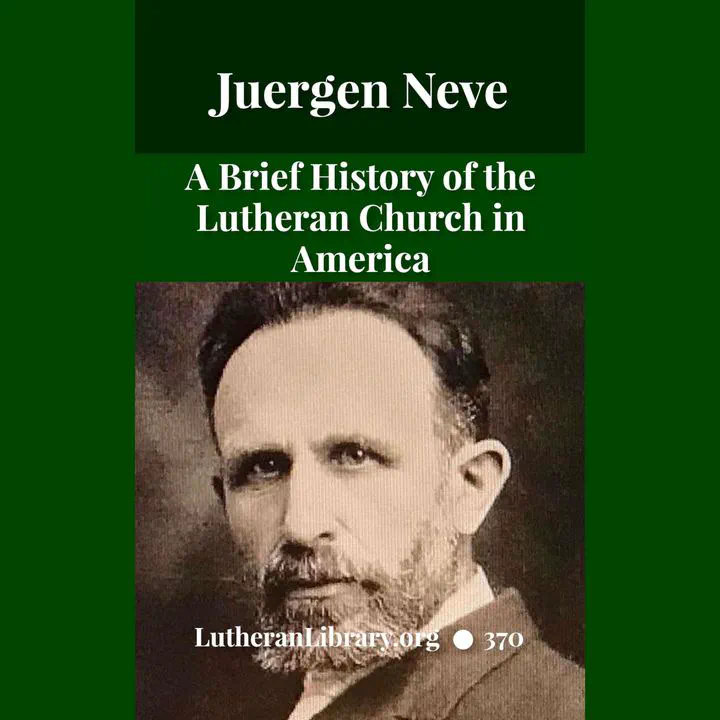A Brief History of the Lutheran Church in America by Juergen Neve

“The ‘Brief History of the Lutheran Church in America,’ …has been kindly admitted as a textbook in almost all theological seminaries of the Lutheran Church in this country… As in the previous edition, so in this one, it has been our aim to furnish a textbook that would serve as a guide for instruction in theological seminaries. Students and teachers alike prefer a book that is easily read. Even a seeming confusion of facts tries their patience. For this reason our ‘Brief History’ views the material from the viewpoint of extension and organization rather than from that of confessional development. The numerous divisions and the use of heavy type even in the body of the text have been made in the interest of perspicuity, and to aid the teacher and student alike readily to catch the leading thoughts. Qui bene distinguit, bene docet. [ He who distinguishes well, teaches well.]
“May it please God to use this ‘Brief History’ as an inspiration among Lutherans in America, especially to increase their loyalty to their Church! — Prof. Neve
Juergen Ludwig Neve (1865-1943) served as professor of Church History, Symbolics, and History of Doctrine at Hamma Divinity School (Ohio Synod) for 34 years. His books include A History of Christian Thought (completed posthumously), Churches and Sects of Christendom, and The History of the Lutheran Church in America.
Level of Difficulty: Primer: No subject matter knowledge needed.
Book Contents
- Literature.
- Important Sources.
- Presentations of the History of the Luth. Church in America as a Whole:
- Histories of Individual Synods:
- Biographies:
- With Reference to Doctrinal Differences:
- With Reference to the Discussion on Predestination:
- Foreword.
- Introductory. Mode of Treatment.
- The First Period. Origin Of Individual Congregations.
- 1 Preliminary History Of The Lutheran Synods Of America.
- § 1. The Dutch Lutherans.
- § 2. The Swedish Lutherans.
- § 3. The German Lutherans.
- 1 Preliminary History Of The Lutheran Synods Of America.
- The Second Period. Congregations Organized Into Synods.
- 2 Muhlenberg And The Founding Of The First Lutheran Synod.
- § 4. Muhlenberg and His Work.
- 3 Further Development Of Muhlenberg’s Organization.
- § 5. Origin of Other Synods.
- § 6. Characteristics of This Period.
- 2 Muhlenberg And The Founding Of The First Lutheran Synod.
- The Third Period. Synods Organized Into Larger Bodies.
- 4 The General Synod.
- § 7. The Founding of the General Synod.
- § 8. The Significance of the General Synod for the Lutheran Church of that Period.
- § 9. Aberrations.
- § 10. Disruption of the General Synod and Origin of the General Council.
- § 11. The Character of the General Synod.
- § 12. The Work of the General Synod.
- § 13. Observations on Statistics.
- 5 The United Synod Of The South.
- § 14. The Origin of the Synod.
- § 15. Characterization.
- § 16. Institutions and Work.
- 6 The General Council.
- § 17. Organization.
- § 18. Character of the Council.
- § 19. Present Status.
- § 20. Institutions and Missions.
- 7 The Synodical Conference.
- § 21. Introductory.
- § 22. How It Came Into Existence.
- § 23. Doctrinal Controversies of Missouri.
- § 24. Its Work.
- The Other Parts Of The Synodical Conference.
- § 25. The General Synod of Wisconsin, Minnesota, Michigan and Other States
- § 26. The Slovak Synod.
- § 27. Practice of the Synodical Conference.
- 8 Independent Synods.
- § 28. The Joint Synod of Ohio.
- § 29. The Iowa Synod.
- § 30. The Buffalo Synod.
- 9 The Norwegians And Danes.
- § 31. The Norwegians.
- § 32. Danish Lutherans in America.
- 10 Small Synods of Different Languages.
- § 33. Small Synods of Different Languages.
- 11 Constitutional Forms of the Lutheran Church in America.
- § 34. Constitutional Forms of the Lutheran Church in America.
- 4 The General Synod.
- 12 General Review.
- § 35. A Discussion of the Development of the Lutheran Church in America.
- § 36. Review of the Extension of the Lutheran Church in America.
- § 37. Appendices.
- Copyright Notice
Publication Information
- Lutheran Library edition first published: 2020
- Copyright: CC BY 4.0